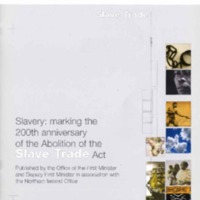
Slavery: marking the 200th anniversary of the Abolition of the Slave Trade Act
The official publication from the Office of the First Minister and Deputy First Minister in association with the Northern Ireland Office, based on the research of historian Nini Rodgers.
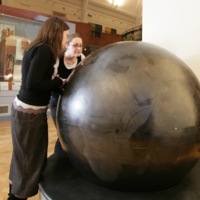
Blue Earth 1807-2007
The sculpture Blue Earth 1807-2007 by African artist Taslim Martin was permanently installed in the newly updated African Worlds Gallery at the Horniman Museum in 2007, to mark the bicentenary. The large iron globe, inscribed with the 18th century image of the slave ship Brookes, traces the routes along which enslaved Africans were transported to the New World, alongside the movement of the products of enslaved labour. The major British ports of Liverpool, London and Bristol are depicted, as well as ports in West Africa and some of the destination ports in North America, the Caribbean and South America. Visitors are encouraged to spin the globe to view slave routes across the world. In 2007-2008, the Horniman Museum also hosted 'La Bouche du Roi' by Romuald Hazoumé.
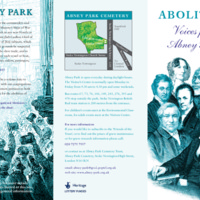
Abolition Voices from Abney Park
Abney Park is a non-denominational cemetery in Stoke Newington, London. The walking tour Abolition Voices from Abney Park was developed to highlight the individuals connected with the abolition of slavery buried there, including the Baptist missionary Reverend Thomas Burchill (associated with Samuel Sharpe and the 'Baptist War' in Jamaica), Reverend Newman Hall and Reverend James Sherman (both associated with abolition in the USA). The grave of Joanna Vassa, daughter of Olaudah Equiano, was identified and restored. The monument to Joanna Vassa was designated Grade II listing by Historic England in 2008 as part of the bicentenary commemorations. There were accompanying talks and school workshops. Abney Park Cemetery Trust was also responsible for the carving of a new memorial stone for the writer Eric Walrond.
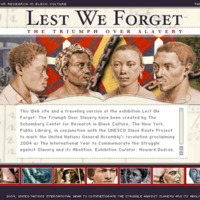
Lest We Forget: The Triumph Over Slavery
Lest We Forget is a travelling exhibition commissioned by UNESCO (United Nations Educational, Scientific and Cultural Organisation) and created by The Schomburg Center for Research in Black Culture, The New York Public Library, and the UNESCO Slave Route Project. It toured several countries in Africa, Europe and North America before arriving in Camden. The exhibition was on display in Swiss Cottage Gallery, Swiss Cottage Central Library in May 2007. It focused less on enslaved Africans as victims and more on the ways in which they reshaped their place in history through the creation of distinct cultural contributions, including language, religion, music and institutions. Swiss Cottage Library also held poetry and discussion events to mark Black History Month in October 2007.
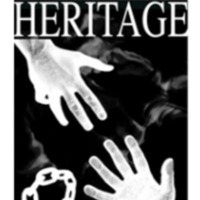
Dark Heritage
Dark Heritage from Bee Arts Community Interest Company comprised The DARK, a sonic art installation, and accompanying participatory educational activities. The DARK touring installation is a pitch black space designed to bring home the horrors of the transatlantic slave trade in the 18th century. The three dimensional soundscape uses ghosts as metaphors for the hidden aspects of the past, based on the Liverpudlian slave-ship worker Edward Rushton, slave ship Captain John Newton, and Kunie, an African man who met Rushton aboard an American ship. A programme of public sessions and creative educational workshops aimed at schools, colleges, youth and community groups were produced in collaboration with Kingswood Primary School in Lambeth. Dark Heritage travelled to six locations in the UK in 2007-08 starting in Greenwich, travelling to Ipswich, Gloucester, University of Hertfordshire, Norwich and finishing in Manchester.
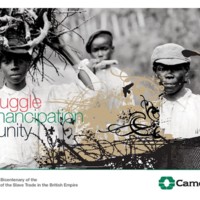
Struggle, Emancipation and Unity
The year-long programme of commemorative events from Camden Council was put together in consultation with the 1807-2007 Taskforce of local African and Caribbean community leaders. The key to these events was remembering slavery through the resistance of Africans, their celebration in their liberation and their unity in tackling present-day inequalities. Camden’s 18th and 19th Century Slavery Trail was created around the area. In eight stops, it explored the lives of men and women connected to the slave trade who lived and worked in the London Borough of Camden. The Resistance Film Season, in partnership with the British Museum, explored the legacy of the slave trade through a mixture of contemporary and classic films. Other events also included local exhibitions, poetry readings, debates and talks.
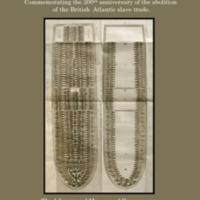
Squaring the Triangle: Freemasonry and Anti-Slavery
The exhibition at the Library and Museum of Freemasonry to mark the bicentenary arose from a project to catalogue their historical collections relating to Masonic history in the West Indies and America between 1760 and 1900. This period covers the establishment of African Lodge, the first Masonic lodge for African-Americans. Its first Master was Prince Hall, a freed slave and respected Boston resident who had fought for the British. From 1847 his name has been synonymous with Prince Hall Masonry, the first major Black Masonic organisation in the world. The library holds eleven letters written by or for Prince Hall. The exhibition and cataloguing of this correspondence enabled the library to start compiling details of early Black and Asian Freemasons in its collections. The exhibition also looked at members in the 18th and 19th century who were both slave owners and abolitionists, and the establishment of lodges in the Caribbean.
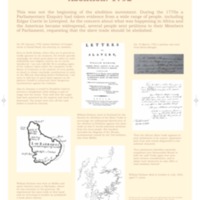
Dumfries and Galloway and the Transatlantic Slave Trade
An exhibition exploring the connections between the Scottish region of Dumfries and Galloway and the transatlantic slave trade toured Dumfries Museum, the Stewartry Museum in Kirkcudbright and Stranraer Museum. At each venue, the exhibition was accompanied by displays of material and a lecture. The catalogue of new research to supplement the exhibition by Frances Wilkins set out to correct misunderstandings about the role of people from the region in the transatlantic slave trade, to prove a history of connections independent of Glasgow or anywhere else. Evidence suggests that men from smaller towns such as Dumfries and Kirkcudbright were involved in the transatlantic slave trade as merchants, slave traders or plantation owners. For example, in the late 18th century, plantation supplies were sent from Kirkcudbright to the island of Grenada; the vessels returned with rum, sugar, and cotton wool.
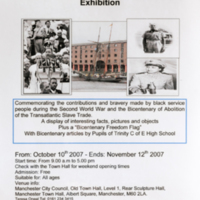
Wartime Black History and the Bicentenary
An exhibition by Manchester City Council held at Manchester Town Hall commemorated the contributions of Black service people during World War II. The exhibition also included the Bicentenary Freedom Flag, to mark commemorations of the Abolition Act of 1807. Alongside exploring the efforts of women, West Indian men, and African men in wartime, the exhibition also told the story of the 761st Tank Battalion of the US Army, known as the Black Panthers Tanker Battalion. Primarily made up of African-American soldiers, the squadron was said to be deployed as a public relations effort to maintain support for the war effort from the Black community.
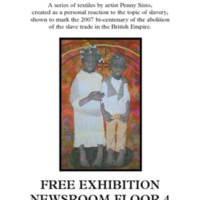
Threads of Strength and Fortitude
Threads of Strength and Fortitude was an exhibition of a series of textiles by artist Penny Sisto, created as a personal response to the bicentenary. The quilts were shipped over from New Albany, Indiana, and exhibited at the Royal Armouries in Leeds. Eight quilts explored the theme of slavery through depictions of servitude, emancipation and the flight to freedom. Pieces on show include 'Slave Ship 1,' which depicts eight enslaved Africans chained by their necks on a slave ship. Another quilt, 'Ran Away', showed a farmer leading Underground Railroad travellers by lantern light. The exhibition was accompanied by an interactive DVD, 'Ordinary People, Extraordinary Courage: Men and Women of the Underground Railroad in the Indiana and Kentucky Borderland'. There was also a series of events, including guest lectures and workshops on the subject of the abolition of slavery aimed at school and community groups. Art-based workshops explored the themes of peaceful resistance.
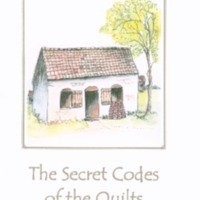
The Secret Codes of the Quilts
The Quaker Quilters of Norwich Quaker Meeting held the Slave Quilts Exhibition at the Friends Meeting House in Norwich in May 2007. By the 1860s in the United States there were organised flights to freedom for enslaved people from the southern plantations via the Underground Railroad – a network of paths leading to the North and Canada. The ‘safe houses’ where assistance was offered on the way were often the homes of Quakers. This exhibition looked to reproduce some of the secret codes said to be hidden within the symbols and patterns featured in quilts made by slaves, to pass on directions to those looking to escape.
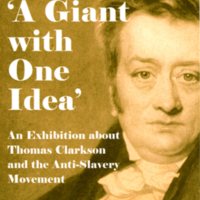
'A Giant with One Idea': An Exhibition about Thomas Clarkson and the Anti-Slavery Movement
A Giant with One Idea told the story of the anti-slavery campaign through the personal narrative of the abolitionist Thomas Clarkson, who was born and raised in Wisbech. The exhibition included an overview of the transatlantic slave trade, major campaigners in the abolition movement, the antislavery campaign after 1807, and details of Clarkson’s travelling chest, which he used to help illustrate the cruelty of the slave trade. The exhibition later travelled to other venues in the area. Accompanying the exhibition was a handling box based on Clarkson’s chest available for schools and community groups, as well as a children’s activity booklet led by the character of Clarkson himself. The museum also supported the publication of a number of books telling the life stories of Thomas Clarkson, and his less well known brother, the naval officer John Clarkson.
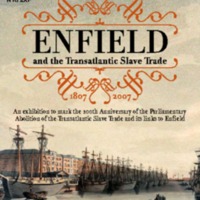
Enfield and the Transatlantic Slave Trade
An exhibition to mark the bicentenary was developed by Enfield Museum Service in partnership with the British Museum and Enfield Racial Equality Council. The exhibition looked at West African culture, the development of the local African community, the links between the transatlantic slave trade and Enfield, wealthy landowners and Quaker abolitionists who lived in the area. Free family days held during school vacations offered traditional Ghanaian story-telling, dancing and drumming, crafts and object handling. Living History Days gave visitors the opportunity to meet actors portraying William Wilberforce and Olaudah Equiano. School workshops included a drama session and performance about a runaway slave developed from material from Lambeth Archive. The museum service also produced a book, edited by Valerie Munday, which explored further the links between Enfield and the slave trade. The book was sent to all schools in the borough, and formed the basis of a teaching resource aimed at Key Stages 2 and 3. Loan boxes and handling collections provided by the museum service include Ghanaian artefacts and items relating to the slave trade. In 2011, Enfield Racial Equality Council unveiled a plaque to commemorate abolition at the Enfield Civic Centre.
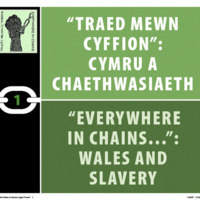
Everywhere in Chains: Wales and Slavery
Everywhere in Chains was an umbrella project created for the bicentenary commemorations in 2007, by a collaboration between Amgueddfa Cymru - National Museum Wales, the National Library of Wales, University of Wales, Bangor and CyMAL: Museum Archives and Libraries Wales (part of the Welsh Assembly Government). An exhibition explored Welsh involvement in slavery, especially focusing on the transatlantic slave trade and its abolition, the Black presence in Wales, and legacies of slavery. This was shown at the National Waterfront Museum in Swansea from May to November 2007 before touring to Wrexham County Borough Museum. The touring version of the exhibition was funded by the Welsh Assembly Government. The exhibition in Wrexham included discussion of the painting 'A Negro Coachboy', thought to commemorate a black servant of John Meller, owner of the Erddig estate in the 18th century.
Alongside the exhibition, the Everywhere in Chains programme also included lectures, formal learning activities and performances. An educational pack was produced by CyMAL and distributed to every school in Wales in 2009-2010. A community project created a forum in which participants from many cultural backgrounds could voice their ideas about enslavement. The Everywhere in Chains Community Heritage Toolkit captured the learning from this project. The toolkit, launched in 2009, was produced to help individuals, groups and organisations to work with culture and heritage providers to undertake projects focused on the role of Wales in the transatlantic slave trade and issues of modern slavery.
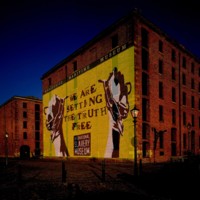
Opening of International Slavery Museum
Liverpool is a port city with a long association with transatlantic slavery. Located on Liverpool's Albert Dock, National Museums Liverpool opened the new International Slavery Museum in 2007, the first stage of a two-part development. The museum aims to promote the understanding of slavery and the transatlantic slave trade and the permanent impact the system has had on Africa, South America, the USA, the Caribbean and Western Europe. It features displays about West African society, the transatlantic slave trade and plantation life, but also addresses issues of freedom, identity, human rights, reparations, racial discrimination and cultural change. The museum also has strong ties with Liverpool’s large Black community. The museum opened on 23 August 2007, designated by UNESCO as Slavery Remembrance Day.
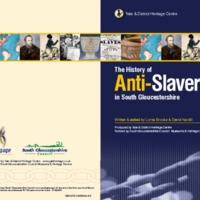
Impact: A history of anti-slavery in South Gloucestershire
This exhibition and booklet were produced as part of South Gloucestershire's Engage 2007 project, in partnership with Yate and District Heritage Centre. Both the exhibition and booklet explored local connections with the history of slavery and anti-slavery in South Gloucestershire. Links identified included the career of Robert Jenkinson of Hawkesbury (later Prime Minister Lord Liverpool), the Caribbean plantations of the Codrington family, the campaign efforts of abolitionist Joseph Sturge and, looking further back in history, St Wulfstan's attempts to abolish the trade in slaves to Ireland in the 11th century. The booklet was written and edited by Lorna Brooks and David Hardill. The exhibition toured the local area, including Thornbury and District Museum, pictured here.
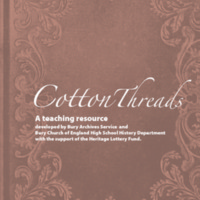
Cotton Threads
Bury Archives and Museum collaborated on an exhibition based on the journals, letters and other papers of John Hutchinson. The Hutchinson family's cotton spinning business had links to slavery in the United States: in 1848, John Hutchinson travelled to America to buy cotton produced by slaves. The exhibition at Bury Art Gallery featured archives, museum objects and paintings that put the papers into a social context. Cotton Threads went on tour to branch libraries, where talks and family workshops explored family histories and the cotton business. Volunteers assisted in conserving, cataloguing and digitising the Hutchinson papers, which were made available online. Primary school pupils took part in workshops held in the exhibition and a resource pack for secondary schools was produced with local teachers (available to download from the Cotton Threads website).
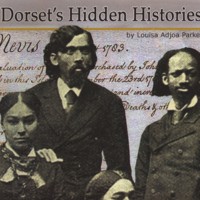
Dorset's Hidden Histories
DEED (Development Education in Dorset) works within the community to develop understanding of global education and cultural diversity. The charity produced and made available to hire the Dorset's Hidden Histories touring exhibition, which explored 400 years of the stories of people with African and Caribbean heritage across Dorset, Bournemouth and Poole. Many Dorset families were involved in slavery, either owning or trading in African slaves, and Black people were brought to Dorset by slave traders to live as servants in the large country houses. The exhibition, which is still available to borrow, also includes details of African American GIs on Poole Quay, a freed enslaved American living in Bournemouth, and Belle Davis, the African-American singer and dancer who performed in Weymouth in 1917. The organisation worked with Louisa Adjoa Parker, a local poet and black history researcher, to provide creative writing workshops to explore the exhibition. An accompanying booklet, written by Parker, can be purchased from DEED.
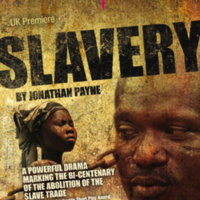
Slavery
A one-act play by Jonathan Payne, 'Slavery' re-tells the personal stories of enslaved Black Americans, using original recordings of interviews conducted by the United States Government's Federal Writers Project in the 1930s. The play brings together a collection of personal testimonials and spirituals (Christian songs created by African slaves in the United States), to explore the consequences of slavery. Presented in 2007 by the cross-cultural London theatre company Tara Arts and directed by Laura Kriefman, the play toured nationally during Black History Month. An Education Resource Pack was produced and drama workshops for schools were held after the performances to explore the issues raised.
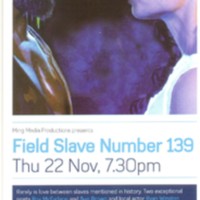
Field Slave Number 139
'Field Slave Number 139' was written and produced by Ava Ming, and commissioned by The Drum in Birmingham as part of their Routes to Freedom programme. The play focuses on a love story between a dark-skinned field slave and mulatto house slave on a plantation in America's Deep South. 'Field Slave Number 139' is written mostly in monologues with occasional interaction between the actors: all three were on stage for the duration of the piece. The 2007 production featured two performance poets and a local actor.